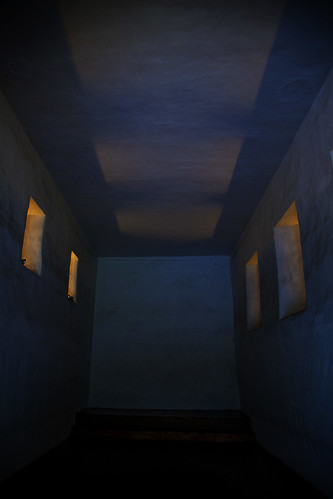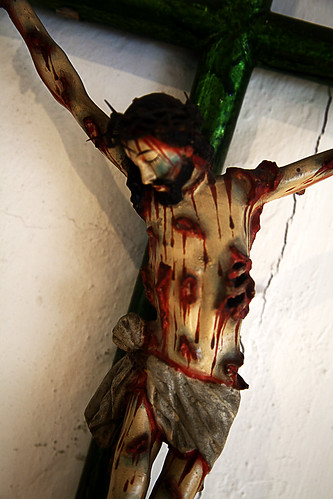In the gloom I see a frightened girl, maybe just 11-years-old, her hair is crudely shorn and she is stripped to her petticoat. She is huddled in the corner, her arms wrapped tightly about her knees, pulling them tight against her chest in a futile effort to stop the spasmodic shivers which are rattling her frozen bones. In her right hand she grips a doll, dressed in all the fashions and fineries she had seen her older sister wearing, fresh from her honeymoon in Madrid. This girl will never see Madrid, the walls of the convent are the boundaries of her much reduced world. Like her sister, she too will marry. She saw the face of her husband hours earlier. He stared down at her with eyes filled with pain, anguish and compassion. His face one great, purple bruise, his temples pouring with blood, his muscles taut through the agony of death and a gaping wound exposing his cracked white ribs.
 |
| Welcome to Heaven, girls |
The order of the Immaculate Conception built its convent in Cuenca in 1599 and cloistered nuns still live there to this day. Of course, you'll never see them but they still sell a herbal water drink (agua de pitimas) from behind a rotating wooden window.
With the slow decline of the convent in our Godless age, it has now been turned into a museum... and a rather good one at that.
You can wander - unimpeded by the smartphone wielding masses - through 30 rooms, crammed with the best examples of religious art in the country. There was an impressive collection of retablos; these were portable nativity sets which could be carried by donkey to the Indian communities as a tool for conversion. The religious figures have often been supplemented with characters from indigenous everyday life to better help the Indians understand the message. The three wise men arrive on llamas and Spanish colonial soldiers take the place of Herod's men.
 |
| The most impressive retablo in the convent |
It's hard to believe in these secular times, but it was a great honour to have a virginal daughter married to Jesus. It might even save the souls of a few family members - who probably deserved a decent dose of damnation for their treatment of the Indians on their haciendas.
The young girl, before the age of puberty, was sent to the convent where she was expected to make a pact with God for life.
On arrival her long locks were sheared off. They would later be used to make wigs for the icons and Virgins used during religious parades. You can still see the wigs crowning the saints and virgins. This creepy archangel was particularly haunting - as the rest of the convent crumbles like the faith which had once supported it, the hair remains as light and curly as the day it was sheared.
 |
| An archangel with the hair shorn from one of the girls |
 |
| Married to Christ |
After this gentle icebreaker the girls had the rest of their lives to devote to Christ. They were permitted only one visit from their family, the timing of which they could choose. They were sealed off from the outside world and would never, in theory, see the face of a man again. Their silent days were filled with prayer and the many duties of convent life - it seems cookery was a particularly popular pastime and the nuns have perfected a sort of cheesy biscuit called the quesadilla (which you can still buy from them today).
I can't help thinking the monks over in Belgium must have had a better time of things. The nuns in Cuenca get herbal water and cheese biscuits while their brothers-in-Christ were scoffing plates of ripe cheese from Flanders' fertile flocks, washed down by gallons of foaming beer.
Cuenca is Ecuador's most beautiful city... in fact, it might be Ecuador's only beautiful city. It's colonial centre has been both carefully preserved and sympathetically restored. Also, the religious beliefs that once supported the convent of the Immaculate Conception have also been better preserved here. Cuenca is Ecuador's most Catholic city and a devotion exists here that I have not seen elsewhere in Ecuador. The city's Cathedral was crammed with worshipers on a wet Wednesday morning. People of all ages and backgrounds were knelt on the cold stone offering prayers to God.

No comments:
Post a Comment